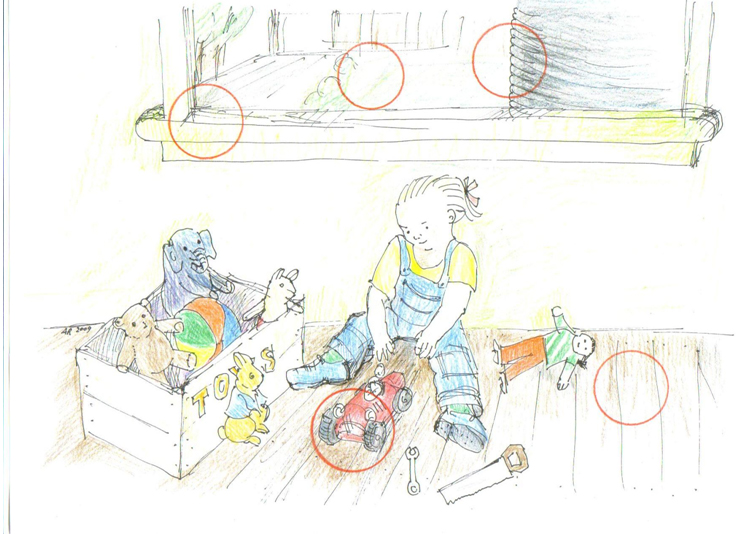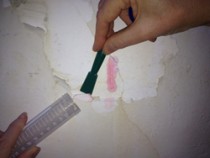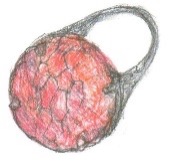|
PDF
version of this file
 DIY-sampling / lab analysis lead test kits
DIY-sampling / lab analysis lead test kits
You take the samples, send them to the NATA lab for analysis, we tell you what the results mean – what to do to make your family
and pets and vegies and chooks lead-safe!
Which samples should I collect?

Good samples to test for lead from the above scene in an old house would include:
- windowsill dust wipe;
- play floor dust wipe;
- vegetable garden soil;
- bare soil in play area;
- rainwater from the kitchen tap;
- any flaking paint especially from wood or metal surfaces;
- painted or PVC toys or other items mouthed by the child; for example:
- children’s painted clothing snaps or fasteners.
Why test for lead at a lab with a LEAD Group Kit?
Test for lead before you renovate or demolish, and before your family or pets or poultry move in or you plant vegetables!
Test paint for lead before deciding how to manage it. Always test poultry soil, water, paint and commercial chicken feed for
lead before eating their eggs.
Test for lead around homes or workplaces to find out if either of them is the source of your or your children’s or pets’
elevated blood lead level (greater than 1 microgram per decilitre). Not enough blood lead testing has been done to know for
sure but it’s a fair assumption that the majority of Australians have a blood lead level above 1 microgram per decilitre.
Knowing where the lead is coming from allows you to remove the lead poisoned individual from the source or the source from
their life, and thus to lower the blood lead level and reduce consequent health impacts, or even prevent early death from
lead poisoning.
 LEAD Group kits include recommendations. Volcano Art Prize 2013 Entry by Ardhika Wira. Lead-safety message: If in doubt about a colour change kit result on paint, send a sample to the lab with a LEAD Group kit. You’ll not only get an exact result back, you’ll also get recommendations on what to do about it! LEAD Group kits include recommendations. Volcano Art Prize 2013 Entry by Ardhika Wira. Lead-safety message: If in doubt about a colour change kit result on paint, send a sample to the lab with a LEAD Group kit. You’ll not only get an exact result back, you’ll also get recommendations on what to do about it!
  Test for lead in order to prevent lead poisoning. Test for lead if you have any reason to suspect that it is present in the soil, dust wipes, or paint in your house; particularly if you intend to renovate, and particularly if you have young children or intend having children. Test for lead in water from new taps and any source of water that doesn’t come from the mains supply: rainwater/tank water, bore water, dam water, ground water, or river water. Test any products you want to be sure do not contain the level or leachable form of lead that would make them unsafe for use. Such products may include children’s toys, jewellery, pewter, artificial turf, ceramic ware, PVC products and chewable kids bibs and clothing snaps and fasteners etc. If you are thinking of growing vegetables, or building a bird or pet or poultry enclosure, you will want to know if the soil contains too much lead. Test for lead in order to prevent lead poisoning. Test for lead if you have any reason to suspect that it is present in the soil, dust wipes, or paint in your house; particularly if you intend to renovate, and particularly if you have young children or intend having children. Test for lead in water from new taps and any source of water that doesn’t come from the mains supply: rainwater/tank water, bore water, dam water, ground water, or river water. Test any products you want to be sure do not contain the level or leachable form of lead that would make them unsafe for use. Such products may include children’s toys, jewellery, pewter, artificial turf, ceramic ware, PVC products and chewable kids bibs and clothing snaps and fasteners etc. If you are thinking of growing vegetables, or building a bird or pet or poultry enclosure, you will want to know if the soil contains too much lead.
We recommend that childcare centres use the kits to test that their equipment, play areas (artificial turf, soil etc) and toys are lead-safe. Landlords can be confident they are renting out lead-safe premises if they have used a LEAD Group Kit to test dust on floors and windowsills, and in garden soil.
What would make you suspect that lead was present in backyard eggs or soil or dust or paint or drinking water or consumer products?
Lead is present in an astonishing number of things especially imported products, (see “Sources of Lead” https://www.lead.org.au/lasn/lasn006.html ) but the greatest sources of lead particles in and around houses has been from paint and leaded petrol, especially in urban areas. Practically all urban backyard chickens in a recent Australian study (Yazdanparast et al 2022) had too much lead in their eggs and while soil was the main source, commercial chicken feed and water were also implicated.
Paint
Any house painted before 1997 (in Australia, where this kit is mainly sold), or before 1978 in the USA, will almost certainly have been painted with paint containing lead, which, if removed or renovated without using lead-safe methods will leave lead dust or particles behind. If you’re not sure about dates, a LEAD Group kit will provide the answer as to how much lead is in the paint.
Leaded petrol
This was phased out in Australia for on-road vehicles in 2002, but there is a legacy of leaded dust in ceiling voids and other building cavities, and in dust in the living space, especially in carpets, and in yards and gardens.
 This lead dust from paint or petrol is the greatest source of lead which children are commonly exposed to in homes. However, sucking on or swallowing leaded jewellery has also caused fatal lead poisoning in children. This lead dust from paint or petrol is the greatest source of lead which children are commonly exposed to in homes. However, sucking on or swallowing leaded jewellery has also caused fatal lead poisoning in children.
There are Posted and Emailed Kits which each come as either 1-Sample, or 2-Sample, or 8-Sample Kits for testing samples of any type:
LEAD Group Emailed Lead Testing Kits can be used to send paint, soil, eggs*, ceiling dust, vacuum dust, toy paint*, jewellery*, ceramic items*, etc to the lab.
LEAD Group Posted Lead Test Kits can be used to send water and/or surface dust wipe samples to the lab, plus any of the above sample types as well, in the case of the 8-Sample Posted Lead Test Kit. You are not required to send all the 8 Samples in one go. You can take some of the samples and send them off to the testing laboratory, and follow up later with any or all of the remaining samples.
Because we believe that every Australian should test their new taps (which typically leach lead in the first couple of years) and all non-mains drinking water for lead, we particularly recommend the ‘2-Sample LEAD Group Posted Lead Testing Kit’. In order to assess the contribution of lead from the tap, you need to send both standing (‘first flush’) and flushed water samples.
Join The LEAD Group today!
Membership is only $10 per annum for individuals, and $132 per annum for organisations (discounted to $100 if you also belong to another association or professional body with aims compatible with The LEAD Group’s).
Membership entitles you to discounts on all our testing kits.
LEAD Group Membership entitles you also to discounts on XRF testing by Portable XRF Services in Perth.
After you become a member, we will send you a coupon code which you will be able to enter at the shop checkout for member pricing eligibility.
*There’s more lab work to prepare eggs, toy paint, jewellery and ceramic items for lead analysis so there are extra charges at the shop for these sample types. Extra charges also apply to paint, soil or dust samples to be examined for the presence of asbestos and there’s a range of other add-ons like fluoride, hardness and pH for water, pesticides scan for eggs, other metals for any sample type, etc.
| | Member Prices | Non-member Prices | | | Emailed | Posted | Emailed | Posted | | 1-Sample Lead Testing Kit | $56 | $66 | $66 | $76 | | 2-Sample Lead Testing Kit | $112 | $122 | $132 | $142 | | 8-Sample Lead Testing Kit | $263 | $273 | $288 | $298 |
*Posted Lead Test Kit prices include postage within Australia and All LEAD Group Kit prices include handling, lab lead analysis charges, results, interpretation, incredibly useful advice & GST.
Sydney Analytical Laboratories are accredited by NATA – the National Association of Testing Authorities. The lab charges The LEAD Group at a charity rate, so the kits are cheaper than if you purchase analysis at a lab as an individual. And you receive the numerical results in writing, by email, ready to print if needed. If you go direct to a lab for lead analyses they will not explain what the results mean. We do, and we advise you on how to respond to the results – what action to take, if any.
Proceeds from the sale of our kits go towards running the free Global Lead Advice and Support Service and maintaining www.lead.org.au; the Lead Safe World Project www.leadsafeworld.com and Volcano Art Prize www.volcanoartprize.com – the three websites of The LEAD Group [ABN 25819463114].
Order Membership and Kits online OR you can phone your details through to 02 9716 0014. You’ll be so glad when you know where the lead is and how to get rid of it.
Videos showing how to use LEAD Group lead testing Kits are now available:
If you would like some ideas on which samples to collect and how to collect some sample types, please check out our You Tube videos:
To see how to collect a dust wipe sample, please check out our You Tube videos at:
The following five videos were made by Nicole Bijlsma of ACES - Australian College of Environmental Studies. Please note that the instruction in these videos to write more than just the sample number and letter on the sample container/bag relates to other labs but in a LEAD Group Kit, the key instruction is to complete the Chain of Custody Form Word docx electronically, and email it back to The LEAD Group in Word format only, on the day you post the samples to the lab:
This fact sheet was written by Elizabeth O’Brien and Anne Roberts for 19th October 2013, updated 8th December 2022. Drawings by Anne Roberts.
PDF
version of this file
|




 LEAD Group kits include recommendations. Volcano Art Prize 2013 Entry by Ardhika Wira. Lead-safety message: If in doubt about a colour change kit result on paint, send a sample to the lab with a LEAD Group kit. You’ll not only get an exact result back, you’ll also get recommendations on what to do about it!
LEAD Group kits include recommendations. Volcano Art Prize 2013 Entry by Ardhika Wira. Lead-safety message: If in doubt about a colour change kit result on paint, send a sample to the lab with a LEAD Group kit. You’ll not only get an exact result back, you’ll also get recommendations on what to do about it!

 Test for lead in order to prevent lead poisoning. Test for lead if you have any reason to suspect that it is present in the soil, dust wipes, or paint in your house; particularly if you intend to renovate, and particularly if you have young children or intend having children. Test for lead in water from new taps and any source of water that doesn’t come from the mains supply: rainwater/tank water, bore water, dam water, ground water, or river water. Test any products you want to be sure do not contain the level or leachable form of lead that would make them unsafe for use. Such products may include children’s toys, jewellery, pewter, artificial turf, ceramic ware, PVC products and chewable kids bibs and clothing snaps and fasteners etc. If you are thinking of growing vegetables, or building a bird or pet or poultry enclosure, you will want to know if the soil contains too much lead.
Test for lead in order to prevent lead poisoning. Test for lead if you have any reason to suspect that it is present in the soil, dust wipes, or paint in your house; particularly if you intend to renovate, and particularly if you have young children or intend having children. Test for lead in water from new taps and any source of water that doesn’t come from the mains supply: rainwater/tank water, bore water, dam water, ground water, or river water. Test any products you want to be sure do not contain the level or leachable form of lead that would make them unsafe for use. Such products may include children’s toys, jewellery, pewter, artificial turf, ceramic ware, PVC products and chewable kids bibs and clothing snaps and fasteners etc. If you are thinking of growing vegetables, or building a bird or pet or poultry enclosure, you will want to know if the soil contains too much lead.
 This lead dust from paint or petrol is the greatest source of lead which children are commonly exposed to in homes. However, sucking on or swallowing leaded jewellery has also caused fatal lead poisoning in children.
This lead dust from paint or petrol is the greatest source of lead which children are commonly exposed to in homes. However, sucking on or swallowing leaded jewellery has also caused fatal lead poisoning in children.